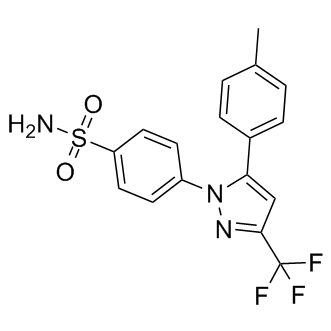| Cas No.: | 169590-42-5 |
| SMILES: | CC1=CC=C(C=C1)C2=CC(C(F)(F)F)=NN2C3=CC=C(C=C3)S(=O)(N)=O |
| Formula: | C17H14F3N3O2S |
| M.Wt: | 381.37 |
| Sotrage: | 2 years -20°C Powder, 2 weeks 4°C in DMSO, 6 months -80°C in DMSO |
| Description: | Celecoxib is a selective COX-2 inhibitor with an IC50 of 40 nM. |
| In Vivo: | Celecoxib demonstrates potent, oral anti-inflammatory activity. Celecoxib reduces acute inflammation in the carrageenan edema assay with an ED50 of 7.1 mg/kg and reduces chronic inflammation in the adjuvant arthritis model with an ED50 of 0.37 mg/kg/day. In addition, Celecoxib also exhibits analgesic activity in the Hargreaves hyperalgesia model with an ED50 of 34.5 mg/kg. Celecoxib has potency equivalent to that of standard nonsteroidal anti-inflammatory drugs (NSAIDs), yet shows no acute GI toxicity in rats at doses up to 200 mg/kg. In addition, it displays no chronic GI toxicity in rats at doses up to 600 mg/kg/day over 10 days[1]. In the KpB mice fed a high fat diet (obese) and treated with Celecoxib, tumor weight decreases by 66% when compare with control animals. Among KpB mice fed a low fat diet (non-obese), tumor weight decreases by 46% after treatment with Celecoxib[3]. Rat models are orally administrated with Celecoxib (20 mg/kg) and/or intramuscularly with Fasudil (10 mg/kg) for 2 weeks. Results demonstrates that the combined use of Celecoxib and fasudil significantly decreases COX-2 and Rho kinase II expression surrounding the lesion site in rats with spinal cord injury, improves the pathomorphology of the injured spinal cord, and promoted the recovery of motor function[4]. |
| In Vitro: | The selective cyclooxygenase-2 (COX-2) inhibitor Celecoxib (10-75 μM) inhibits the proliferation of the NPC cell lines in a dose-dependent manner. Celecoxib (25 and 50 μM) induces apoptosis and cell-cycle arrest at the G0/G1 checkpoint in the NPC cell lines, which is associated with significantly reduced STAT3 phosphorylation. The genes downstream of STAT3 (ie, Survivin, Mcl-1, Bcl-2 and Cyclin D1) are significantly down-regulated after exposure to Celecoxib (25 and 50 μM)[2]. |

 To enhance service speed and avoid tariff delays, we've opened a US warehouse. All US orders ship directly from our US facility.
To enhance service speed and avoid tariff delays, we've opened a US warehouse. All US orders ship directly from our US facility.




















